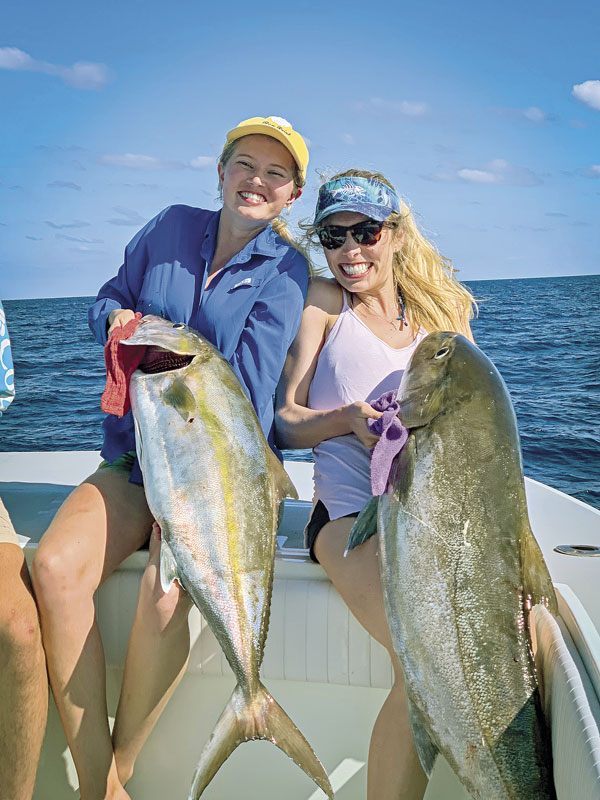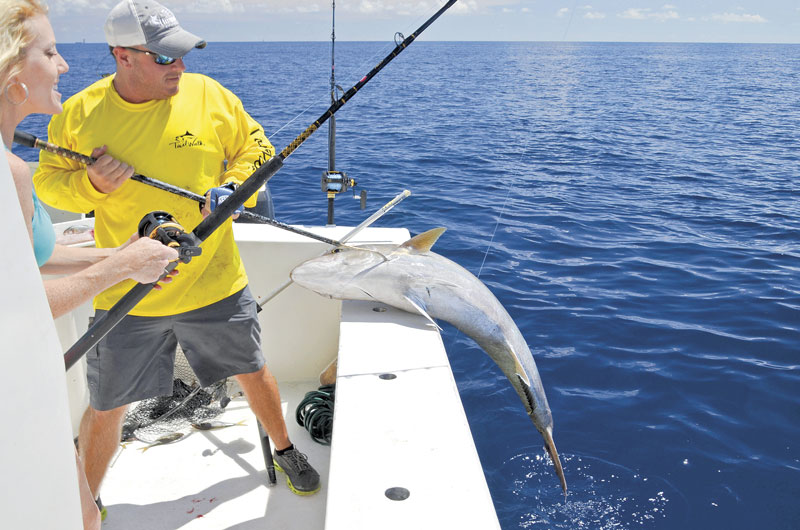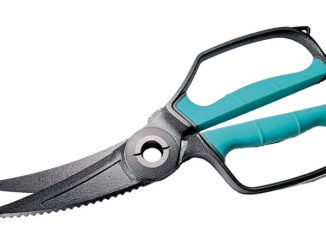
Stubburn and stout, amberjack earn their “reef donkey” reputation
About 45 miles south of Cocodrie, La. the live fish 300 feet down in the water began a jittery twitching, making the rod tip dance. Moments later, the nervous twitching stopped, replaced by the broom-stick stout rod bending down almost to the surface of the cobalt-clear waters with the reel screaming as the angler battled one of the most powerful fish in the sea.

“To practice fighting a big amberjack, get on the roof of a house with a broomstick, a short length of rope and a refrigerator,” expressed Tommy Pellegrin of Custom Charters (985-851-3304, www.customchartersllc.com) in Cocodrie. “Tie the rope to the end of the broomstick and to the refrigerator. Hold the broomstick and kick the refrigerator off the roof. Anyone who can stop that refrigerator from hitting the ground can fight an amberjack!”
The giant fish don’t make lightning runs like tuna. They just head for cover and dare anglers to pull them to the surface. The world record weighed more than 163 pounds. The Louisiana record weighed 140 pounds, caught near the Horseshoe Lump salt dome. The Mississippi record, a 126-pounder, also came off a salt dome.
Nicknamed “reef donkeys” for their size and power, amberjack like to stay around any hard structure in water at least 150 feet deep. Unless a larger goliath grouper shows up, amberjack dominate reefs, shipwrecks and other hard spots. Voracious predators, amberjack eat practically anything they can ambush from their lairs including fish, squid and crustaceans.
“People call AJs ‘reef donkeys’ because they’re harder to pry off a reef than a donkey off a mountain!” said Ben Allen with Jerry McClure’s Biloxi Blue Water Charters (228-243-5365, www.biloxibluewater.com) in Biloxi, Miss. “Amberjack fishing off the Mississippi Coast is pretty good with many fish ranging from 40 pounds up to more than 100 pounds. If we’re going specifically for amberjack, we run a minimum of 50 miles south of Biloxi to get into at least 200 feet of water.”

Big game gear
Catching a big amberjack requires tough big game equipment. When hooked, they quickly run to the sharpest, most gnarly, barnacle-encrusted structure where they can break the line by rubbing it against objects. Divers around reefs and petroleum platforms report seeing massive AJs with several hooks hanging out of their mouths.
“The biggest mistake people make when fishing for amberjack is underestimating their power,” Pellegrin said. “It’s not like fighting a tuna or marlin by letting it run in the open. An amberjack runs straight to the structure to cut the line. If people struggle to catch a 40-pound amberjack, think how much trouble they’d have fighting a 100-pounder!”

For pulling monster amberjack from cover, use big-game reels with strong drags and loaded with at least 80-pound test line. Many people use tough braid for the main line. Attach that to an unlimited class rod. Secure it in a strong rod holder and crank the horses.
“Tighten up the drag so the fish can’t run back into the structure,” said Gray Long with Go Long Charters (225) 252-5315, www.golongcharters.com) in Venice, La. “If we get a big one on, we’ll pull it away from the structure with the motors so we can fight it in the open.”
With abundant steel supports, petroleum platforms can hold large fish concentrations. The oldest platforms typically offer the best fishing. Anglers can spot a big platform miles away so everyone fishes it. Sometimes, the biggest fish stay 40 to 50 yards away from the rigs, especially heavily pressured ones.
“Louisiana lost many good rigs in recent years, but some remain,” Pellegrin said. “We also fish hard bottom areas. Whenever running the boat, I pay attention to the sonar. I look for any kind of discrepancy, like a bottom rise. If I find something interesting, I’ll stop to investigate. I’ve found a lot of hard bottoms and fish like that over the years.”

Try the salt domes
Natural formations like salt domes and reefs attract big AJs. Even a small rock pile in deep water could hold a few giants. Small natural structures in deep water might receive considerably less fishing pressure than highly visible platforms. In addition, both Louisiana and Mississippi established many artificial reefs over the years. For Louisiana artificial reef locations, see www.wlf.louisiana.gov/page/artificial-reefs. For Mississippi, visit dmr.ms.gov/artificial-reef.
“We don’t have many close rigs off the Mississippi Coast,” Allen said. “We don’t really start encountering offshore rigs until we’re out about 50 miles. As the crow flies, the rigs we fish are closer to Venice, La., but we don’t have to run the Mississippi River. Many people from both Louisiana and Mississippi fish several salt domes and some natural hard-bottom formations off the Mississippi River delta.”
As visible structures like platforms disappear, a good electronics unit becomes even more imperative for locating amberjack. Use electronics to search all around any structure to locate fish. In current, AJs normally hover on the upstream side facing into the flow. With quality electronics, anglers should be able to determine where fish want to stay.
“A good electronics unit is a must to find amberjack, especially bigger fish,” Pellegrin said. “Always keep an eye on what’s going on beneath the boat. We want to be looking at fish on the finder before sending any lines down or we’re just wasting bait on so many other things that can eat it.”
To catch big jacks, most anglers simply drop a live bait to the bottom or the proper depth. Amberjack might grab a squid, cut bait or a fish strip undulating in the current, but most AJs like squirming meat. Hardtail jacks, or blue runners, about eight to 12 inches long make excellent jack baits. Mullets, croakers, pogies, also called menhaden, ruby lips, also known as tomtate, squirrelfish, hornbellies (also called Atlantic bumper) and other baitfish can also bring on mighty bites. A bruiser amberjack can engulf a sizable fish. Larger baits also keep smaller nibblers like triggerfish from stealing.
Give ‘em a big bite
“People can never use a bait too big for an amberjack,” Long said. “They can eat a substantial hunk of meat. I like hardtails the best, but we also use live pogies and big hornbellies. Sometimes, we catch AJs on dead pogies or cut bait, but any live bait would be better than dead bait. In the Venice area, we always have current, so we use 20-24 ounce lead weights with 12/0 to 13/0 circle hooks on 200-300 pound leaders.”
Rig live baits on a Carolina rig so the fish can swim more naturally. The more active it stays, the more likely it will attract attention. Use just enough weight to get the bait to the bottom or the proper depth. Clip the tail fin so the fish struggles to swim, sending vibrations radiating through the water. Anglers can hook baitfish many ways, but through the jaw sends it down head first fast.
My favorite way to fish for amberjack is with a large, live bait. The bigger the better,” Allen said. “Anglers can hook live baitfish in the tail, through the lips or through the eyes. Personally, I prefer to hook them through the back end, but we’ve caught them every way we could hook them.”
Although considered a deep-water fish, big amberjack don’t always hang right at the bottom. Sometimes, they hover about halfway down. Use electronics to determine the depth they like best and drop baits just above them.
“We don’t drop a live bait all the way to the bottom,” Long said. “We might drop the bait halfway down. Sometimes, they hang right on the bottom, but most of the time, they suspend in the water column. Amberjack come up to grab a bait.”
Amberjack might hit artificials. For suspended jacks, drop heavy jigs to them. Metal jigs mimic baitfish as they flutter down and tiny nibblers won’t tear them apart. Anglers could tip a jig with natural bait for flavor and scent.
“Mark the depth where the fish want to stay,” Pellegrin said. “Send the jig deeper than the fish. Then, speed it up through the depth where the fish are. Don’t bring it all the way to the surface. Keep sending it down and jigging it up through the fish. Usually, it doesn’t take more than once or twice for them to hit it if they are feeding.”
Even fish near the bottom might rise to eat something enticing. Sometimes, jacks respond to chumming activity on the surface. Rig a drift line with live bait and toss it into the chum slick. A drift line might also attract grouper, big snapper, cobia, mackerel or wahoo — perhaps even tuna or sailfish. Fly rod enthusiasts occasionally cast for jacks in chum slicks.
Anglers could catch colossal jacks while trolling live baits, diving plugs, squid or feather baits. Amberjack might hit anything that would interest a wahoo, tuna, sailfish or marlin. Some anglers troll when moving from one reef or platform to another. A bonus monster amberjack rising to take a trolled temptation would make a welcome addition to any fish box!

There’s more than one type of amberjack
When people say “amberjack” they generally mean greater amberjack, the largest and most abundant of four closely related species. The list also includes lesser amberjack, almaco jack and banded rudderfish.
Lesser amberjack look very similar to juvenile greaters, but with proportionately larger eyes and deeper bodies. Lesser amberjack seldom weigh more than 10 pounds. The world record Almaco weighed 136 pounds. Rudderfish top out at about five pounds.
“It is a little difficult to tell a greater from a lesser amberjack,” explained Dr. Bob Shipp, (bobshipp.com) a renowned marine biologist and author of Dr. Bob Shipp’s Guide to Fishes of the Gulf of Mexico. “A greater amberjack is a more elongate fish, about four times longer than it is deep.”
To differentiate between a banded rudderfish and an Almaco jack, note the anal fins. On a rudderfish, the anal fin is only about half as long as its dorsal fin. In the other three, the anal fin is about three-quarters the length of its dorsal fin.
State and federal regulations, season dates if any, as well as size and creel limits could differ for each of these species. Therefore, always check the regulations before keeping any kind of a fish.


